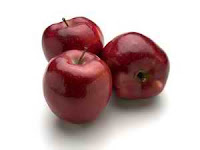Allergy
One form of apple allergy, often found in northern Europe, is called birch-apple syndrome, and is found in people who are also allergic to birch pollen.[citation needed] Allergic reactions are triggered by a protein in apples that is similar to birch pollen, and people affected by this protein can also develop allergies to other fruits, nuts, and vegetables. Reactions, which entail oral allergy syndrome (OAS), generally involve itching and inflammation of the mouth and throat,
In other areas, such as the Mediterranean, some individuals have adverse reactions to apples because of their similarity to peaches.[citation needed] This form of apple allergy also includes OAS, but often has more severe symptoms, such as vomiting, abdominal pain and urticaria, and can be life-threatening. Individuals with this form of allergy can also develop reactions to other fruits and nuts. Cooking does not break down the protein causing this particular reaction, so affected individuals can eat neither raw nor cooked apples. Freshly harvested, over-ripe fruits tend to have the highest levels of the protein that causes this reaction.
Breeding efforts have yet to produce a hypoallergenic fruit suitable for either of the two forms of apple allergy.
Toxicity of seeds
The seeds of apples contain small amounts of amygdalin, a sugar and cyanide compound known as a cyanogenic glycoside. Ingesting small amounts of apple seeds will cause no ill effects, but in extremely large doses can cause adverse reactions. There is only one known case of fatal cyanide poisoning from apple seeds; in this case the individual chewed and swallowed one cup of seeds. It may take several hours before the poison takes effect, as cyanogenic glycosides must be hydrolyzed before the cyanide ion is released.
Nutrition
The proverb "An apple a day keeps the doctor away.", addressing the health effects of the fruit, dates from 19th century Wales.Fruit specialist J.T. Stinson popularized this proverb during a lecture at the 1904 World's Fair in St. Louis, Missouri.
Research suggests that apples may reduce the risk of colon cancer, prostate cancer and lung cancer. Apple peels contain ursolic acid which, in rat studies, increases skeletal muscle and brown fat, and decreases white fat, obesity, glucose intolerance, and fatty liver disease.
Apple peels are a source of various phytochemicals with unknown nutritional value and possible antioxidant activity in vitroThe predominant phenolic phytochemicals in apples are quercetin, epicatechin, and procyanidin B2.
According to the United States Department of Agriculture, a typical apple serving weighs 242 grams and contains 126 calories with significant dietary fiber and vitamin C content.
Apple juice concentrate has been found to increase the production of the neurotransmitter acetylcholine in mice. Other studies have shown an "alleviation of oxidative damage and cognitive decline" in mice after the administration of apple juice.Fruit flies fed an apple extract lived 10% longer than other flies fed a normal diet.
Apples, with skin (edible parts)
Nutritional value per 100 g (3.5 oz)
Energy 218 kJ (52 kcal)
Carbohydrates 13.81 g
- Sugars 10.39
- Dietary fiber 2.4 g
Fat 0.17 g
Protein 0.26 g
Water 85.56 g
Vitamin A equiv. 3 μg (0%)
- beta-carotene 27 μg (0%)
- lutein and zeaxanthin 29 μg
Thiamine (vit. B1) 0.017 mg (1%)
Riboflavin (vit. B2) 0.026 mg (2%)
Niacin (vit. B3) 0.091 mg (1%)
Pantothenic acid (B5) 0.061 mg (1%)
Vitamin B6 0.041 mg (3%)
Folate (vit. B9) 3 μg (1%)
Vitamin C 4.6 mg (6%)
Vitamin E 0.18 mg (1%)
Vitamin K 2.2 μg (2%)
Calcium 6 mg (1%)
Iron 0.12 mg (1%)
Magnesium 5 mg (1%)
Manganese 0.035 mg (2%)
Phosphorus 11 mg (2%)
Potassium 107 mg (2%)
Sodium 1 mg (0%)
Zinc 0.04 mg (0%)
Fluoride 3.3 µg
FOR MORE INFO VISIT http://en.wikipedia.org/wiki/Apple
.jpg)
.jpg)
.jpg)



.jpg)

.jpg)
0 comments :
Post a Comment